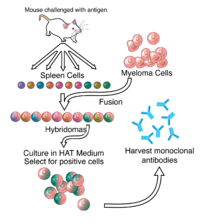
Photo from wikipedia
Biomacromolecules have long been at the leading edge of academic and pharmaceutical drug development and clinical translation. With the clinical advances of new therapeutics, such as monoclonal antibodies and nucleic… Click to show full abstract
Biomacromolecules have long been at the leading edge of academic and pharmaceutical drug development and clinical translation. With the clinical advances of new therapeutics, such as monoclonal antibodies and nucleic acids, the array of medical applications of biomacromolecules has broadened considerably. A major on‐going effort is to expand therapeutic targets within intracellular locations. Owing to their large sizes, abundant charges, and hydrogen‐bond donors and acceptors, advanced delivery technologies are required to deliver biomacromolecules effectively inside cells. In this review, strategies used for the intracellular delivery of three major forms of biomacromolecules: nucleic acids, proteins, and peptides, are highlighted. An emphasis is placed on synthetic delivery approaches and the major hurdles needed to be overcome for their ultimate clinical translation.
Journal Title: Advanced Healthcare Materials
Year Published: 2022
Link to full text (if available)
Share on Social Media: Sign Up to like & get
recommendations!